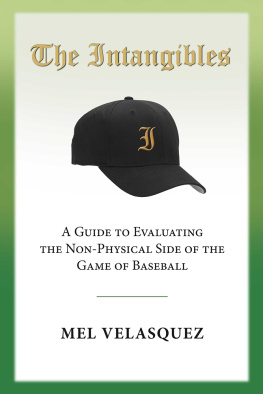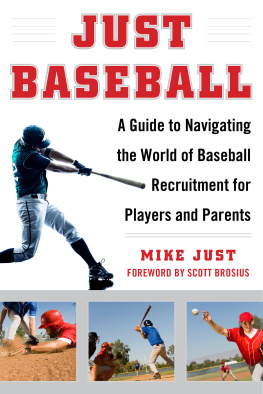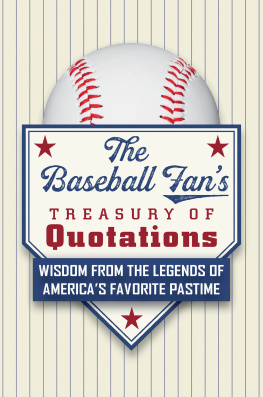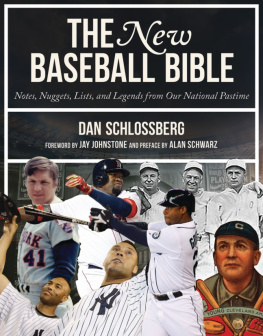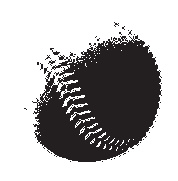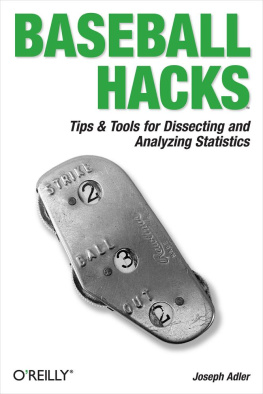Mel Velasquez - The Intangibles: A Guide to Evaluating the Non Physical Side of the Game of Baseball
Here you can read online Mel Velasquez - The Intangibles: A Guide to Evaluating the Non Physical Side of the Game of Baseball full text of the book (entire story) in english for free. Download pdf and epub, get meaning, cover and reviews about this ebook. year: 2018, publisher: BookBaby, genre: Children. Description of the work, (preface) as well as reviews are available. Best literature library LitArk.com created for fans of good reading and offers a wide selection of genres:
Romance novel
Science fiction
Adventure
Detective
Science
History
Home and family
Prose
Art
Politics
Computer
Non-fiction
Religion
Business
Children
Humor
Choose a favorite category and find really read worthwhile books. Enjoy immersion in the world of imagination, feel the emotions of the characters or learn something new for yourself, make an fascinating discovery.
- Book:The Intangibles: A Guide to Evaluating the Non Physical Side of the Game of Baseball
- Author:
- Publisher:BookBaby
- Genre:
- Year:2018
- Rating:5 / 5
- Favourites:Add to favourites
- Your mark:
The Intangibles: A Guide to Evaluating the Non Physical Side of the Game of Baseball: summary, description and annotation
We offer to read an annotation, description, summary or preface (depends on what the author of the book "The Intangibles: A Guide to Evaluating the Non Physical Side of the Game of Baseball" wrote himself). If you haven't found the necessary information about the book — write in the comments, we will try to find it.
The Intangibles is the Ultimate Guide for Evaluating the Non-Physical Side of the Game of Baseball!
The term intangible is an abstract word that benefits from clarification. Intangibles are a cluster of non-physical attributes, traits, and habits. Because the concept of an intangible is non-physical, it is a matter of quality rather than quantity. In simple terms, this means intangibles have to be assessed rather than measured. I think we would all agree that measurement of physical attributes is much easier to attain than an assessment of non-physical attributes. This book addresses the challenge to assess the non-physical side of the game of baseball.
Baseball Owners, Executive Administrators, General Managers, Managers, Coaches, Scouts, College Recruiters, Parents, Fans, Umpires, The Media, The Players, and everyone else in the baseball world use the term intangibles in reference to a baseball players non-physical attributes. However, when the term intangibles is used are we all talking about the same thing? Are we in the baseball world sure we are applying a consensus meaning with similar sub-categories? The purpose of this book is to clarify the concept and makeup of the intangibles for those who need to or like to evaluate baseball talent. An adjacent goal is to provide from a baseball perspective consistency throughout the industry with the utilization of the term intangibles and related terms. Finally, the ultimate goal of this book is to help players assess themselves to make the proper intellectual and emotional adjustments to give themselves the best opportunity to succeed!
One more point to note, as you read this book about the non-physical side of the game of baseball, i.e. the mental, the emotional, and even to a degree the spiritual, it is important to understand it is written as a guide and is not to be read as an epic of any sort. It is purposely written as a brief easy read and is to be used as a source of reference that could be revisited as many times as needed. Furthermore, even though this book is written about and for skilled baseball players, much of what is written is transferable to skilled softball players as well as to athletes in general.
Mel Velasquez: author's other books
Who wrote The Intangibles: A Guide to Evaluating the Non Physical Side of the Game of Baseball? Find out the surname, the name of the author of the book and a list of all author's works by series.

